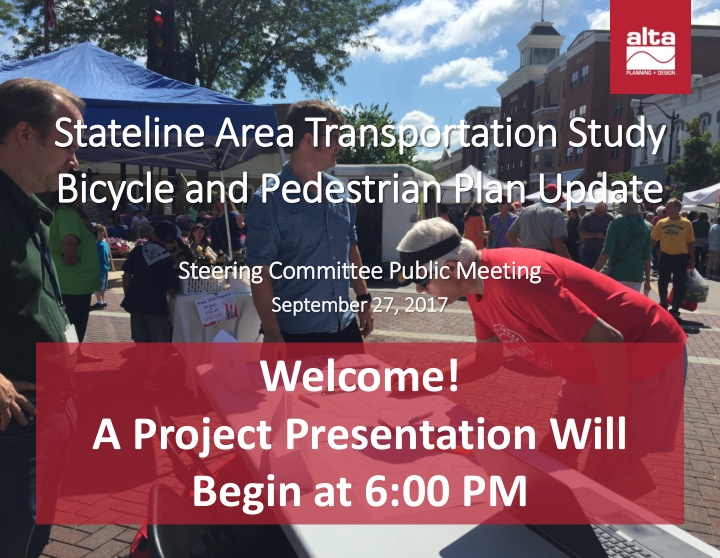



Stateline A Area Transportation S Study Bicycle and Pedestri rian Pl Plan Update Steer ering C Committee P ee Public M c Meet eting September 27, 27, 2017 2017 Welcome! A Project Presentation Will Begin at 6:00 PM
Topics to cover • Current conditions • Key Findings • School and Online Surveys • The Next Steps – Making Recommendations • Questions
Existing Bicycling and Walking Facilities
Pedestrian Level of Stress
Bicycle Level of Stress
Crash Frequency
Crashes by Severity
Equity Analysis
Equity Analysis • Crash Frequency Equity: Concentration of Equity: Concentration of • • Residents over 65 Residents under 18
Equity Analysis • Crash Frequency Equity: Limited English Equity: No Access to • • Proficiency Automobile
Equity Analysis • Crash Frequency Equity: No High School Equity: Concentration of • • Diploma Non-White Population
Demand Analysis
Demand Analysis • Demand: Learn • Demand: Retail
Demand Analysis • Crash Frequency • Demand: Live • Demand: Play
Demand Analysis • Demand: Retail • Demand: Transit
Key Findings: • A palette of bicycle and pedestrian infrastructure types for people of all ages and abilities will help connect the region. Previous plans rely on signed bicycle routes and off-street trails to build routes. • Beloit has historically acted as the region’s center. Downtown Beloit, South Beloit, and Rockton, as well as Rock Township at the northern end of the SLATS area, are important areas to connect through regional walking and bicycling routes. • The region lacks east-west connectivity. Residents mentioned this as well as a desire to improve north-south connections into downtown Beloit and the riverfront.
Key Findings: • Bicycle infrastructure installed since the 2010 system plan and the 2014 study are prime opportunities to upgrade to striped bike lanes. The programmed Park Avenue road diet will enhance connectivity at the state line and will illustrate the benefits of reallocating street space to balance the needs of people walking, bicycling, and driving. • Residents desire places to walk and bike that feel like the riverfront: comfortable, separated from traffic, and scenic. They look for connections to the river as well as comfortable routes in their home communities.
Key Findings (continued): • Areas of high need must be included in system planning efforts: Rockton Township near Rockton Bog Nature Preserve, South Beloit east of South Beloit Municipal Park, central and western Beloit, and Janesville south of Southern Wisconsin Regional Airport. • In Wisconsin, areas with the highest demand for walking and bicycling correlate with areas of high levels of socioeconomic need. The correlation is not as pronounced on the Illinois side of the study area. • Residents’ perceptions of barriers to walking and bicycling are echoed in mapping analyses that investigate streets’ level of walking and bicycling comfort.
Key Findings (continued): • Streets perceived as high-stress routes in urban areas have multiple lanes and high traffic speeds. High stress routes in rural areas lack space to separate people walking and bicycling from people driving at high speeds. • Low-stress areas are primarily located in residential neighborhoods. However, residents must cross busy roads to reach important destinations. • Group bicycle rides and events occur frequently in the region. Local groups fill an advocacy role and are knowledgeable of local lower stress bike routes that connect to destinations.
Key Findings (continued): • Pedestrian crashes occur mainly at intersections of busy streets (i.e., arterials and collectors). • Bicycle crashes occur mainly at intersections of busy streets that lack bicycle specific infrastructure, such as bike lanes. West Beloit is one exception. Many crashes in this area occurred on streets with low posted speed limits and low traffic volumes. • The majority of bicycle and pedestrian crashes resulted in injury.
School Survey • 13/33 Schools Responded = 39% Response Rate • No Bike and Walk to School Day • Kids walk or bike at every school • Top barriers to walking and biking include distance and neighborhood and traffic safety
Online Survey Results For Work Trips: 79% Use a Car (Includes Carpooling); 17% • Use a Bike; 8% Walk; 3% Use Transit Non-work trips: 90% Car, 7% Biking, 3% Walking • Most People walk 5 days a week for exercise • Most People bike 2 days a week for exercise • The top three reasons people walk and bike are: Fitness, • Getting Outdoors and Having Fun Top three priorities for infrastructure: More Trails, More On • Street Bikeways, Better Intersections and crossing for Pedestrians Top Barriers for Walking and Biking; Traffic too fast, Difficult • crossings at major streets; Roads, Trails and Sidewalks don’t feel safe; no convenient routes Respondents between ages of 26-65 (69%); 55% M, 45% F •
The Next Steps – Making Recommendations Next Steps: Multi-modal Design Opportunities • Funding Opportunities • Non-Infrastructure Opportunities •
Mixed Traffic Yield Roadway Advisory Shoulder Bike Boulevard Wayfinding Signage
Visually Separated Buffered Bike Lane Paved Shoulders Bike Lane Contra-Flow Bike Lane
Physically Separated Shared Use Path Sidewalk Separated Bike Lane Sidepath
Funding Opportunities Roadway Resurfacing Roadway Reconfiguration Roadway Widening
Non-Infrastructure Opportunities
Questions? Tim Gustafson AICP timgustafson@altaplanning.com www.statelinewalkbike.com Charlie Short charlieshort@altaplanning.com
Recommend
More recommend